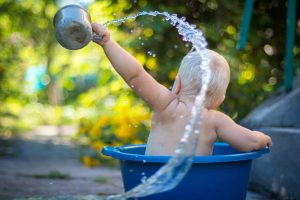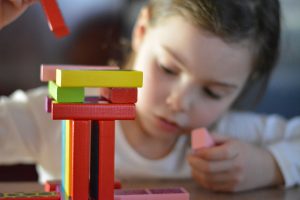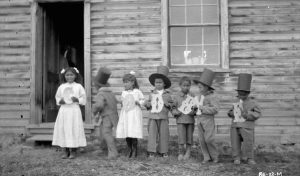The Importance of Play
2.1 Characteristics of Play
Play is:
- Active
- Involves pretending and symbolism
- Voluntary
- Meaningful to the child
- Enjoyable for the child
- Episodic, shifting as interests change
- Challenges the child’s abilities and imagination (Shipley, 2012, p.36
Rubin, Fein, and Vandenberg (1983) identify six factors that distinguish play from non-play.
- “Play is intrinsically motivated; that is, it comes from inside the child, and it is not motivated by competition, or by social demands.
- Play focuses on means, not ends; it is process oriented rather than product oriented.
- Play occurs when objects are familiar; exploration occurs when objects are unfamiliar or not understood.
- Play involves pretending, which means engaging in activities that have an “as if,’ representational, or non-literal quality.
- Play is free of the externally imposed rules that distinguish play from games.
- Play is characterized by the active involvement of the participant and, therefore, excludes daydreaming, flitting from one thing to another, and mindless exploration.” (Shipley, 2012, p.37)
2.2 Types of Play
Mildred Parten (1932) observed two- to five-year-old children and noted six types of play. Three types she labeled as non-social (unoccupied, solitary, and onlooker), and three types were categorized as social play (parallel, associative, and cooperative). The table below describes each type of play. Younger children engage in non-social play more than those older; by age five associative and cooperative play are the most common forms of play (Dyer & Moneta, 2006, p.587-592).
Table 1: Parten’s Classification of Types of Play
Category |
Description |
| Unoccupied Play (Birth to 3 months) | Children’s behavior seems more random and without a specific goal. This is the least common form of play. |
| Solitary Play (Birth to 2 Years) | Children play by themselves, do not interact with others, nor are they engaging in similar activities as the children around them. |
| Onlooker Play (2 Years) | Children are observing other children playing. They may comment on the activities and even make suggestions but will not directly join the play. |
| Parallel Play (2+ Years) | Children play alongside each other, using similar toys, but do not directly interact with each other. |
| Associative Play (3-4 Years) | Children will interact with each other and share toys but are not working toward a common goal. |
| Cooperative Play (4+Years) | Children are interacting to achieve a common goal. Children may take on different tasks to reach that goal. |

2.3 Categories of Play and Related Styles of Play
Category of Play |
Related Styles of Play |
|
Functional Play
|
|
|
Symbolic Play
|
|
|
Constructive Play
|
|
|
Games with Rules Play
|
|
(Shipley, 2012)
Functional Play: Exploring, inspecting, and learning through repetitive physical activity.
- Exploratory play in infancy includes behaviors such as filling/emptying, pushing/pulling, and rolling. Exploratory play in toddlerhood includes behaviors such as combining, sorting, transferring items, and manipulating interlocking objects such as Duplo.
- Repetitive or Practice Play is when children repeat skills or behaviors they have already mastered; for example, an infant following a moving object with their eyes.
- Testing Play is when children challenge their motor abilities; for example, a toddler’s first attempts at using a small indoor slide.

- Imitative Play is the first type of play, evident in infancy, where children simply imitate the actions of a parent or caregiver; for example, children imitating an adult who is clapping their hands.
- Pretend Play involves children using objects, actions, or ideas to represent other objects, actions, or ideas using their imaginations; for example, making a phone call by holding a small unit block up to their ear and talking.
- Dramatic play evolves from pretend play, where children start to create their own versions of adult behaviors, rather than just imitating adult behaviors; for example, taking a baby doll for a walk in a stroller.
- Sociodramatic play is pretend play with others; for example, one child pretending to make supper and serving it to another child.
- Thematic Play is a more complex form of dramatic play, where a familiar theme is present; for example, playing “school.”
- Fantasy play involves make-believe characters, rather than real-life characters; for example, children pretending to be Super Heros.
- Representational play emerges when children start to use familiar objects in appropriate ways to represent their environment; for example, pretend to cook a meal using pots and pans from the kitchen.

Constructive Play: Using materials to create or build something.
- Productive Play involves using materials to create an intended result: building towers with unit blocks.
- Creative Play is a type of productive play that provides more opportunities for self-expression; for example, using modelling clay to make imaginary vehicles to park in a pretend garage.
- Reproductive Play is a more advanced form of productive play, where materials are used to recreate real-world objects: for example, using unit blocks to build a garage for toy cars.

Games with Rules Play
- This type of play begins the transition from commonly held definitions of “play” (as defined earlier by Rubin, Fein & Vandenberg) to more structured games with externally set rules and expectations. For the purposes of this textbook about creative play, games with rules will not be explored in detail.
2.4 The Value of Play
Young children’s ways of learning require an approach to curriculum that allows them to build concepts and skills in integrated learning contexts. Such an approach supports children with analyzing a problem to discover a possible solution, experimenting with, and testing ideas, exchanging ideas with others, thinking creatively, cooperating with others to reach a goal, and focusing their attention and organizing their behavior as they play with others. These skills and dispositions work together to give children a foundation that enhances development and learning in all domains.
Early learning programs use numerous strategies to support children’s play, such as observing and documenting, planning the learning environment, providing engaging and appropriately challenging materials, and being responsive to children’s interest in engaging in play.
Through observations of children’s play, teachers can deepen their appreciation of the value of play in early learning. For example, imaginary play is an important means of exploring ideas and social behavior and roles among preschool-age children. While older infants and toddlers engage in solitary imaginary play, such as feeding a stuffed animal or making a roaring sound while pushing a toy truck across the carpet, preschoolers engage with one or more peers in the more complex and elaborate form of imaginary play called “sociodramatic” play. In this type of play, children cooperate with one another to create a story and “script,” assume various roles, figure out appropriate “costumes” and “props,” and negotiate new ideas for play, such as, “I want to be a wolf, not a dog!”
Because imaginary play holds such rich potential for promoting children’s cognitive, linguistic, social, and physical development, high-quality early learning programs recognize play as a key element of the curriculum. Children’s spontaneous play is a window into their ideas and feelings about the world. As such, it is a rich source of ideas for curriculum planning (Lockett 2004). For example, if a teacher observes a group of children repeatedly engaging in imaginary play about illness or hospitalization, she or he might decide to convert the playhouse area into a veterinary clinic, adding materials to stretch their play. The educator might also read children stories involving doctors, hospitals, getting sick, and getting well. The educator’s observations of children’s resulting conversations and activities would suggest ways to deepen or extend the curriculum further. In thinking of ways to extend the curriculum, it will be important that teachers ensure that the materials used, and themes built upon are culturally familiar to the children and value children’s cultural heritage.
While involved in play, children are challenged to meet the language, problem- solving, and social competencies of their peers. When play is interesting and important to children, they are eager to learn new vocabulary, new physical skills, and new social behaviors that will allow them to stay engaged in play (Jones and Reynolds 2011). Many three-year-old children, for example, have not yet mastered socially appropriate ways to enter other children’s play.
Coaching by a sensitive, observant teacher on appropriate language for asking to join play can help a child overcome this hurdle, thereby opening a new area for learning.
When educators regularly observe and document brief, subtle moments of children’s learning through play, those records can help families understand how useful and important play is in helping children to learn and grow. For example, a teacher might report a child’s language and social development to the parent of a three-year-old: “I watched Sarah standing outside the playhouse area today. Instead of just watching the other children or wandering through their play without getting involved as she often does, she brought the children a book to read to the ‘baby’ in the family. They asked her if she wanted to be the big sister, and she said yes and joined right in. I have been thinking about ways to help her learn how to use her language to get involved in play with other children, but she figured out her own, creative way to join them.”
During the early years, children grow markedly in their knowledge and skills in all areas of development. The dramatic increase in their emotional, social, cognitive, and language knowledge and skills occur hand in hand with the development of key areas of the brain, particularly the prefrontal cortex and its connections with the limbic system. Children are naturally curious and driven to learn about the way the world works and often develop and test hypotheses through observation and experimentation. Children’s learning and development in all domains progress well when they are provided with appropriately challenging opportunities for play and exploration, with the support of skilled teachers who scaffold learning experiences.
2.5 What Children Learn Through Play
Just like the “whole child” is often broken down into developmental domains for studying, so too is learning. Many aspects of learning occur simultaneously; it is integrated and connected. To define learning we often break it into categories. Because the connection between play and learning is so important, the way it is broken down exists in many forms. Table 2.5.1 is a compilation of skills tying development into learning.
Table 2.5.1 What Children Learn Through Play
Domain |
How it is Tied to Learning |
|
Physical
|
|
|
Cognitive
|
|
|
Language
|
|
|
Social
|
|
|
Emotional
|
|
|
Creative
|
|

Pause to Reflect

Haudenosaunee and Anishinaabe families use cradleboards to carry their infants from birth to toddler stages. As the infant develops, various objects such as leather straps, shells, and beadwork are securely attached to the rainbow (top) of the cradleboard to attract their attention and develop visual acuity and observation skills. Older children play with infants in the cradleboard, often mimicking their parents’ actions and language.
Which developmental domains are activated with the use of a cradleboard?
2.6 The Freedom of Play and Open-endedness
One of the hallmarks of early childhood education is what is typically referred to as ‘free play.’
In his theoretical elaboration of play, van Oers (2014) differentiates the notion of ‘free play’ into two concepts: freedom from and freedom to. As he emphasizes, in discussions about ‘free play,’ children’s right to play free of adult ‘interference’, as it is often labelled – clearly indicating the negative connotations of teacher participation in these kinds of activities – is emphasized, that is, what he refers to as freedom from. However, he further argues, the freedom of play may be differently understood; as the freedom to pursue activities in unforeseeable directions, that is, being responsive to the inherent open-endedness of activities we call play. This latter conceptualization of the freedom of play is what he refers to as freedom to; that is, children are free to explore and pursue what they engage in without needing to know beforehand where it will lead them. Where their play may end up, does not, van Oers emphasizes, preclude teacher participation in these activities.
Pause to Reflect

It is estimated that over 150 000 Indigenous children attended residential schools in Canada. The last residential school closed in 1996.
The Indian Act of 1876 made it compulsory for every Indigenous child to attend residential school from the ages of 4 – 16. The schools were often a significant distance from their communities to minimize interactions with their family. Most children were forcibly removed from their families and segregated from siblings. Strict rules were enforced to ensure that Indigenous children adopted the languages, culture, and ways of life of mainstream society. Many children were abused.
How do you think the residential school system impacted typical childhood development?
Important Things to Remember
- Play is defined as an activity that is: active, voluntary, episodic, meaningful, and enjoyable for the child, involves pretending and symbolism, and challenges a child’s abilities and imagination.
- There are six types of play in Parten’s classification of play: unoccupied, solitary, onlooker, parallel, associative, and cooperative.
- There are four categories of play: functional, symbolic, constructive, and games with rules.
- Children’s spontaneous play is a window into their ideas and feelings about the world and is a rich source of ideas for curriculum planning.
- Skill development in different domains is integrated, connected, and can occur simultaneously.
- “Free Play” is when children are free to explore and pursue what they engage in without needing to know beforehand where it will lead them. Where their play may end up does not preclude teacher participation in these activities.
References
Dyer, S., & Moneta, G. (2006). Frequency of parallel, associative, and co-operative play in British children of different socioeconomic status. Social Behavior and Personality: An international journal, 34(5)
Jones, E., Reynold, G. (2011). The Play’s the Thing: Teachers’ Roles in Children’s Play. New York: Teachers College Press.
Lockett, A. (2004). Continuous Curriculum: Planning for Spontaneous Play, Kirkless Children &Young People Service, Learning
Rubin, K., Fein, G., & Vandenberg, B. (1983). Play: In P.H. Mussin (series ed.) & E.M. Hetherington (vol. Ed.), Handbook of Child
Psychology: Socialization, personality, and social development (4th ed., pp. 693-774). New York, NY: Wiley
Shipley, D. (2012). Empowering Children: Play-Based Curriculum for Lifelong Learning, Nelson Canada.
van Oers, B. (2014). Cultural-historical perspectives on play: Central ideas. In L. Brooker, M. Blaise, & S. Edwards (Eds.), The Sage handbook of play and learning in early childhood

